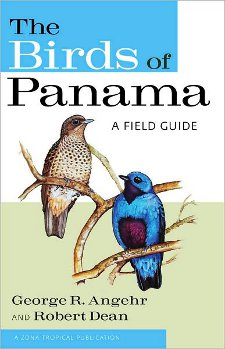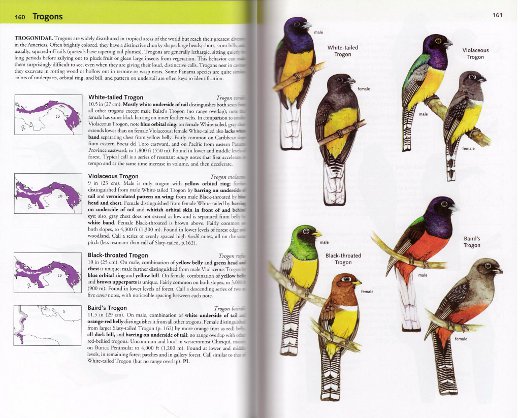Reviewed by Grant McCreary on February 26th, 2012.
The Neotropics. I doubt that many non-birders have ever heard that word. In fact, even Microsoft Word doesn’t understand it, as evinced by the red squiggle underneath it as I’m typing this. But birders – to them, the mere mention of this word conjures images of quetzals, toucans, and other fantastic birds, leaving them with a strange, far-away look in the eyes. Or maybe that’s just me. The sheer number of bird species living in these (for the most part) relatively small countries is staggering. Although that is great for birders, there are drawbacks. Existing field guides for many countries in the neotropics are behemoths, more akin to bricks than the field guides we’re accustomed to using. And they’re just about as user-friendly as bricks.
Panama has such a guide – A Guide to the Birds of Panama, by Robert S. Ridgely and John A. Gwynne, Jr. (first published in 1976, with a second edition in 1989). Don’t get me wrong, it was a very useful guide for its time as it was one of the first modern field guides for any country in this region. But it is big, heavy, and has the plates bunched together in the middle of the book. It contains a lot of great information, but is more of a handbook/reference than a field guide. I share all of this to help you understand how much this new field guide to the birds of Panama was needed.
The Birds of Panama includes all of the regularly occurring birds of Panama (over 900!) in a relatively compact field guide. Unlike its predecessor, it includes the species accounts and range maps on the page facing the illustrations, making it much more user-friendly.
Illustrations
The Birds of Panama is illustrated with paintings by Robert Dean. Most species have one or two illustrations, and for the most part variation due to sex, age, breeding, as well as identifiable subspecies, is depicted. Each plate includes only five species on average. Even though the illustrations are reproduced relatively largely, there was still plenty of space to label them with the species’ name and any appropriate identifiers (male, female, etc). This is a welcome change from most neotropical guides that cram as many birds as possible onto each plate and label them only with numbers. In fact, there is almost too much space left on the plates! Some annotated pointers (a la the Sibley or Collins guides) would have filled the space nicely, but this is a minor quibble.
The art is good, but some of the color reproduction seems to be a little off. Where the birds are the same, The Birds of Panama shares artwork from The Birds of Costa Rica (from the same publisher and artist). Most of the illustrations appear identical. However, many illustrations in the Costa Rica guide seemed “washed out”. The coloration of the same birds in Panama appears much richer and better. Unfortunately, to my eye other species in the Panama guide suffer the opposite problem: they appear too dark/heavily saturated (i.e. Wood-pewees, and Blue-headed and Philadelphia Vireos). Likewise, the blue of the male Cerulean Warbler appears too deep, not its unique shade of sky blue.
Species Accounts
- Size – length in both inches and centimeters; wingspan for some, such as raptors and seabirds
- Field Marks – with most significant in bold; comparison to similar species
- Relative Abundance – abundant, common, etc (terms defined in introduction)
- Migratory Status – including months they are found in Panama
- Range – both within the country and altitudinal range
- Habitat – including foraging height
- Vocalizations
- Endemics – regional and national endemics are noted
The text is surprisingly extensive and seems very helpful, at least for species I’m familiar with. However, I did notice that there were no vocalization descriptions for the kingfishers. I also wish the text sections were separated or marked somehow so that it wasn’t just a single, big block of text.
The range maps are nicely sized, with colors indicating permanent, breeding, winter, and migratory ranges, along with dots for vagrant records.
A 23-page introduction describes the book and gives some notes on taxonomy and the country. The anatomical features of birds are illustrated and described on six (!) pages. Lastly, there is a two-page spread of adult raptors in flight, which would have been better placed in the body of the book.
Comparison to Other Guides
So does The Birds of Panama replace the older one from Ridgely and Gwynne? In a word, yes. It is obviously better suited for use in the field since it’s smaller and lighter, with the accounts opposite the plates. Ridgely does have more extensive text, but you won’t actually miss much if you only have this new guide; I was very surprised at how much information Angehr was able to include. You will lose the bird-finding information in Ridgely, but you’d be much better off with A Bird-Finding Guide to Panama anyway.
Recommendation
If you’re fortunate enough to go birding in Panama, The Birds of Panama is the field guide you want with you. It’s not perfect, but it’s the best guide available for this amazing birding destination.
Disclosure: I get a small commission for purchases made through links in this post.
Disclosure: The item reviewed here was a complementary review copy provided by the publisher. But the opinion expressed here is my own, it has not been influenced in any way.






Comment